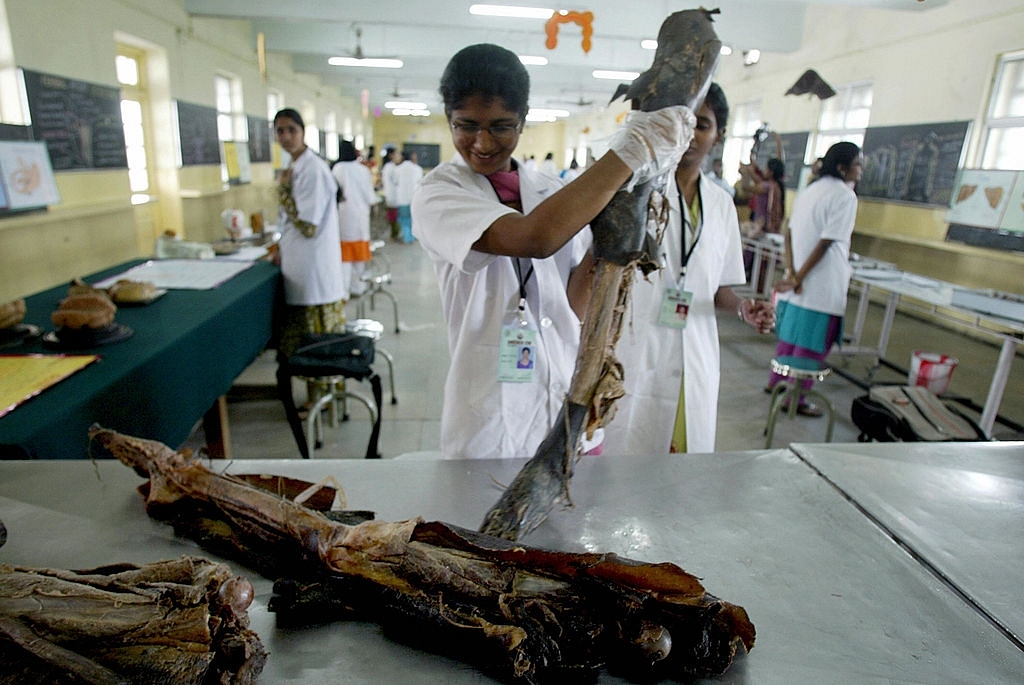Ideas
Pvt Medical College Fees Go Through The Roof In TN, Karnataka; We Will Produce Greedy Docs, Not Healers
- When education becomes this costly, who is it serving?

A scene from a medical college (NOAH SEELAM/AFP/Getty Images)
Private medical education is rapidly pricing itself out of business. If it continues on the current lines, where fees for non-merit students are shooting sky-high due to extortionate capitation fees, it is also likely to produce rapacious rogues rather than caring doctors or surgeons, making a mockery of the Hippocratic Oath.
Thanks to the Medical Council of India’s decision to close down some 50 colleges, there is a supply crunch in medical seats. The Times of India reports that undergraduate medical seats obtained under the management quota, that earlier used to cost Rs 75 lakh, now costs Rs 1.25 crore in Karnataka. For post-graduate seats, rates can go higher in the range of Rs 3-5 crore. And over and above these are annual fees that could vary from a few thousand to even over Rs 1 lakh. And we haven’t even started computing the costs of books, lab fees, hostel costs, etc. In Tamil Nadu, the same newspaper reports in another story, the average cost of studying at a good college is around RS 1.85 crore.
This beats common sense. An MBBS doctor who has ended up paying Rs 1.25 crore over five years, apart from annual fees, has essentially incurred a total cost (real and opportunity cost) exceeding Rs 2 crore during the time he has spent studying. At a 10 per cent compounding rate annually, Rs 1.25 crore works out to more than Rs 2 crore over the five years, assuming all the money was invested in Year One. (I am deliberately simplifying this calculation to make a point. If we assume the money is invested over five years, the future value of this investment would be around Rs 1.5 crore)
Someone who pursues a post-graduate degree by paying, say, Rs 3 crore, would, over the eight years he will end up studying, have incurred an actual-cum-opportunity cost of Rs 6.5 crore, again at a 10 percent annual compounding rate, assuming all the money was invested in Year One. If we assume that the money will be paid in equal instalments over eight years, we would get a cost figure just above Rs 4.2 crore.
A simple point: Rs 2 crore invested in an equity mutual fund, assuming a conservative 10 percent annual return, will give you a recurring annual income of Rs 20 lakh even without a medical education (and tax-free, since equity gains attract zero tax). And Rs 6.5 crore will get you Rs 65 lakh – more than Rs 5 lakh per month. Instead of an equity fund, if you had invested in a fixed maturity plan or even a taxable fixed deposit at interest rates of, say, eight percent, you will get annual incomes of Rs 16 lakh and Rs 56 lakh respectively (taxable, except in the case of a fixed maturity plan, which will give you indexation benefits).
Why would anyone assured of such high starting incomes merely from investing the cash in mutual funds instead of donating it to a private medical college promoter, go through the pain of five or eight years of medical education just to start practising medicine?
Will such a doctor or surgeon, having invested such a large amount to get a professional degree, be focused on recovering his money or treating his patients with care and consideration?
Will such a doctor treat his profession as a dedication to heal and cure, or as a licence to gouge patients for money?
Those with a conscience will migrate abroad, for they can then seek a return on investment in dollars, but that’s about it. Our medical education will not serve us.
And remember, those choosing not to waste this kind of money, could use their time learning other (cheaper) skills, and taking up other earning opportunities. The money not invested in medical education is money for jam; returns from this corpus come over and above what you can anyway earn with lesser skills.
Of course, this argument does not apply to merit students who become doctors at relatively low fees.
The larger point is this: when education becomes this costly, who is it serving?
Introducing ElectionsHQ + 50 Ground Reports Project
The 2024 elections might seem easy to guess, but there are some important questions that shouldn't be missed.
Do freebies still sway voters? Do people prioritise infrastructure when voting? How will Punjab vote?
The answers to these questions provide great insights into where we, as a country, are headed in the years to come.
Swarajya is starting a project with an aim to do 50 solid ground stories and a smart commentary service on WhatsApp, a one-of-a-kind. We'd love your support during this election season.
Click below to contribute.
Latest